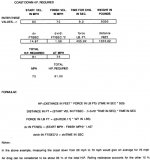Beavis
Member
Offline
I own an MkII GT6 and I've never been able to find any hard data on its drag coefficient. I'm interested in this number since I'm building an electric car out of it, and aerodynamics are the single largest energy eater it will face. With less power needed to go a certain speed, cruising range gets extended.
Anyway, I've heard from others that the per Mk III GT6 has a coefficient drag of .32. Does this at all seem accurate?
One must keep in mind that the MkIV Spitfire, which is a convertable and inherently will not have as good aerodynamics as a coupe, has a .42 Cd according to this page:
https://www.teknett.com/pwp/drmayf/triumph.htm
Given that number, .32 doesn't seem that unreasonable since it is not a convertable. However, I found a simulation of a GT6 MkI being run that had the Cd at .47, this not being hard data:
https://64.233.179.104/search?q=cache:Qdz..."GT6"&hl=en
Any aerodynamic data on the Mk I and Mk II GT6, and out of curiousity, the Mk I, II, and III Spitfires?
I'd really love to know. Thanks.
Anyway, I've heard from others that the per Mk III GT6 has a coefficient drag of .32. Does this at all seem accurate?
One must keep in mind that the MkIV Spitfire, which is a convertable and inherently will not have as good aerodynamics as a coupe, has a .42 Cd according to this page:
https://www.teknett.com/pwp/drmayf/triumph.htm
Given that number, .32 doesn't seem that unreasonable since it is not a convertable. However, I found a simulation of a GT6 MkI being run that had the Cd at .47, this not being hard data:
https://64.233.179.104/search?q=cache:Qdz..."GT6"&hl=en
Any aerodynamic data on the Mk I and Mk II GT6, and out of curiousity, the Mk I, II, and III Spitfires?
I'd really love to know. Thanks.

 Hi Guest!
Hi Guest!

 smilie in place of the real @
smilie in place of the real @
 Pretty Please - add it to our Events forum(s) and add to the calendar! >>
Pretty Please - add it to our Events forum(s) and add to the calendar! >> 

